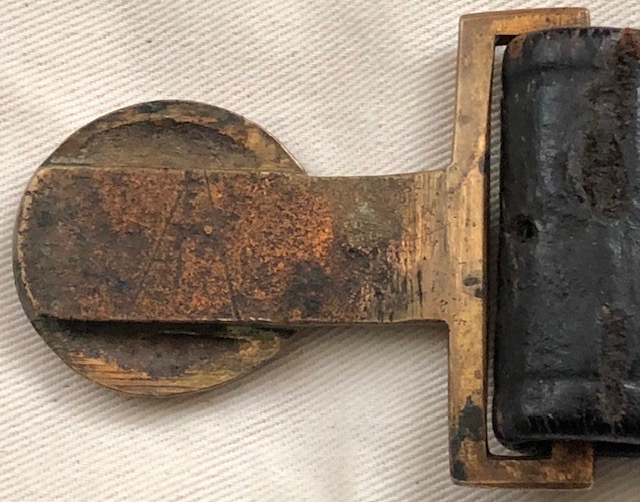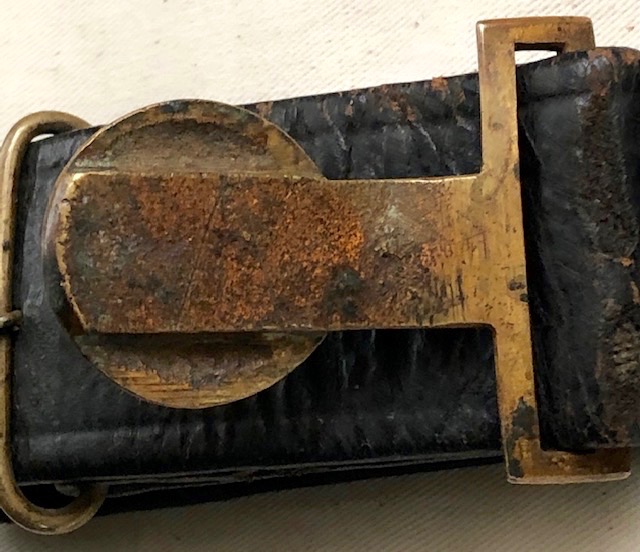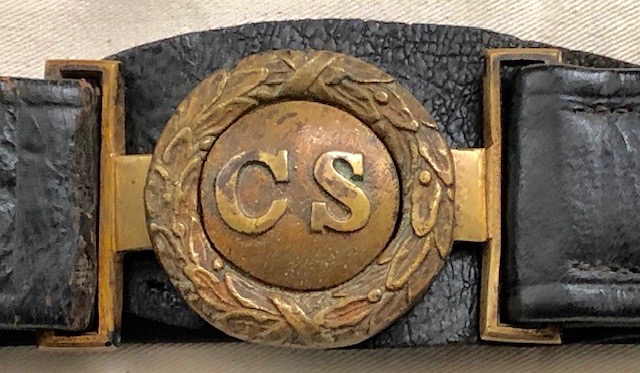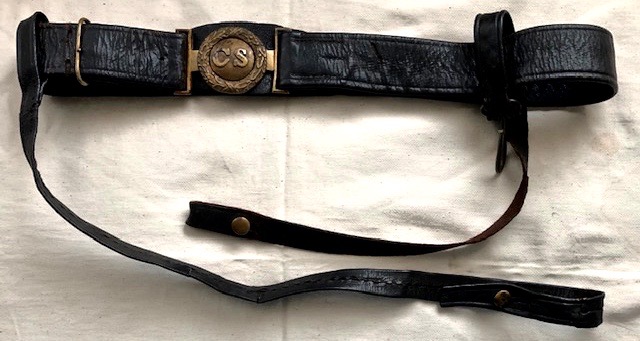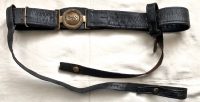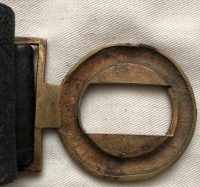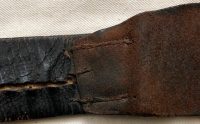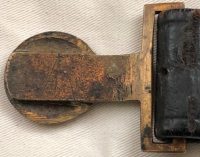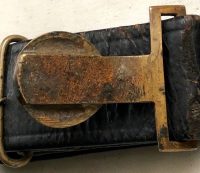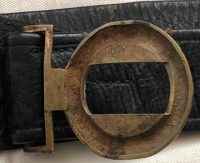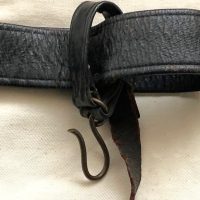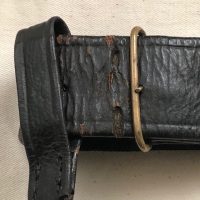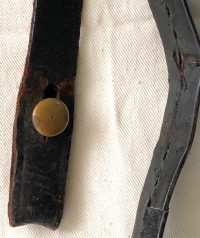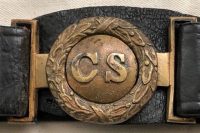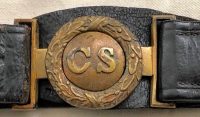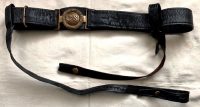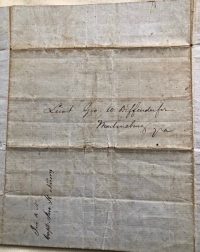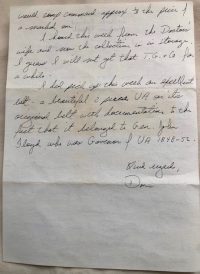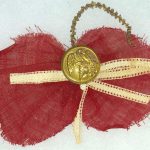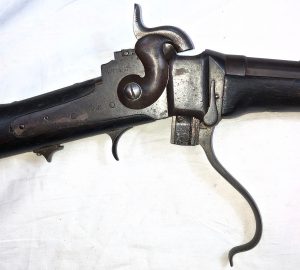Fine CS Tongue and Wreath Plate on Id’d Original Sword Belt
This is a superior and rare example of a CS tongue and wreath plate, still affixed to its original sword belt. The plate is a Richmond Arsenal style plate, which remains in fine condition. The plate exhibits some original file, finishing marks on its reverse side, as well as some remnants of original gilding. The belt is a high quality, pleated and folded leather style, retaining both of its original sword hanger straps, with all studs and snaps in place; when we first obtained the belt, the longer sword hanger was broken, albeit all there, so we have had it expertly repaired by joining the original two lengths which had become separated.
SOLD
Fine CS Tongue and Wreath Plate on Id’d Original Sword Belt – This is a superior and rare example of a CS tongue and wreath plate, still affixed to its original sword belt. The plate is a Richmond Arsenal style plate, which remains in fine condition. The plate exhibits some original file, finishing marks on its reverse side, as well as some remnants of original gilding. The belt is a high quality, pleated and folded leather style, retaining both of its original sword hanger straps, with all studs and snaps in place; when we first obtained the belt, the longer sword hanger was broken, albeit all there, so we have had it expertly repaired by joining the original two lengths which had become separated. This belt comes with a letter of provenance from long time and highly respected collector, Don Tharpe, indicating that the belt was the wartime possession of Captain John R. Nunn of Co. I, 2nd Virginia Infantry. Nunn, prior to the war, had service in Co. A of the 122nd Virginia Militia. During the Civil War, Nunn was WIA at the Battles of Malvern Hill and Chancellorsville. Nunn, having experienced prior military training, mustered into the 2nd Virginia Infantry at the rank of Captain. This is a fine example of a Confederate officer’s belt, identified to a Virginia infantry officer. The belt and plate are in excellent condition. Accompanying the belt is a lengthy, wartime letter dated October 4th, 1861, written and signed by Captain Nunn, to Lt. George W. Diffenderfer.
John R. Nunn
Residence was not listed; Enlisted as a Captain (date unknown). He also had service in: “A” Co. VA 122nd Militia Infantry
John R. Nunn
Residence was not listed; Enlisted on 3/10/1862 at Winchester, VA as a Private. On 3/10/1862 he mustered into “I” Co. VA 2nd Infantry (date and method of discharge not given) He was listed as: * Wounded 7/1/1862 Malvern Hill, VA * Returned 10/31/1862 (place not stated) (Estimated day) * Wounded 5/3/1863 Chancellorsville, VA * Hospitalized 5/10/1863 Richmond, VA * Hospitalized 6/13/1863 Staunton, VA * Returned 9/15/1863 (place not stated) (Estimated day) * Detailed 11/1/1863 Staunton, VA (For 60 days light duty) * On rolls 4/30/1864 (place not stated) (Listed as on detached duty) Promotions: * 2nd Lieut 1/7/1863
2nd VA Infantry
Organized: Charles Town, VA on 4/18/61
Mustered Out: 4/9/65
| From | To | Brigade | Division | Corps | Army | Comment |
| Jun ’61 | Jul ’61 | 1st | Army of Shenandoah | |||
| Jul ’61 | Oct ’61 | 1st | 2nd | Army of Potomac | ||
| Oct ’61 | Nov ’61 | Stonewall | 2nd | Dept of Northern Virginia | ||
| Nov ’61 | May ’62 | Stonewall | Valley District | Dept of Northern Virginia | ||
| May ’62 | Jun ’62 | Stonewall | Jackson’s | Valley District | Dept of Northern Virginia | |
| Jun ’62 | May ’64 | Stonewall | Jackson’s/Johnson’s | 2nd | Army of Northern Virginia | |
| May ’64 | Jun ’64 | Terry’s Consolidated | Gordon’s | 2nd | Army of Northern Virginia | |
| Jun ’64 | Dec ’64 | Terry’s Consolidated | Gordon’s | Valley District | Dept of Northern Virginia | |
| Dec ’64 | Apr ’65 | Terry’s Consolidated | Gordon’s | 2nd | Army of Northern Virginia |
2nd Virginia Infantry
| 2nd Regiment, Virginia Infantry | |
| Active | May 1861 – Spring 1865 |
| Disbanded | 1865 |
| Country | Confederate States of America |
| Allegiance | Virginia |
| Branch | Confederate States Army |
| Type | Regiment |
| Role | Infantry |
| Engagements | American Civil War: First Battle of Bull Run–Battle of Kernstown I–Battle of Cross Keys–Battle of Port Republic–Battle of Gaines Mill–Second Battle of Bull Run–Battle of Fredericksburg–Battle of Gettysburg |
| Commanders | |
| Notable commanders |
Colonel J.Q.A. Nadenbousch |
The 2nd Virginia Volunteer Infantry Regiment was an infantry regiment raised in today’s western Virginia and what became West Virginia during the American Civil War for service in the Confederate States Army. It would combine with the 4th, 5th, 27th, and 33rd Virginia infantry regiments and the Rockbridge Artillery Battery and fight as part of what became known as the Stonewall Brigade, mostly with the Army of Northern Virginia.[1]
Units
The 2nd Virginia was assembled at Charles Town on April 18, 1861, then moved (gathering further units en route) to Harper’s Ferry to seize the armory. Its ten companies were from the counties of Clarke, Frederick, Jefferson, and Berkeley.
| Sortable table | |||
| Company | Nickname | Recruited at | First Commanding Officer |
| A | Jefferson Guards | Jefferson County | John W. Rowan |
| B | Hamtramck Guards | Shepherdstown, Jefferson County | Vincent Moore Butler |
| C | Nelson Rifles | Millwood, Clarke County | William N. Nelson |
| D | Berkeley Border Guards | Martinsburg, Berkeley County | John Q.A. Nadenbousch |
| E | Hedgesville Blues | Hedgesville, Berkeley County | Raleigh T. Colston |
| F | Winchester Riflemen | Winchester, Frederick County | William L. Clark, Jr |
| G | Botts Greys | Charles Town, Jefferson County | Lawson Botts |
| H | Letcher Riflemen | Duffields, Jefferson County | James H.L. Hunter |
| I | Clarke Rifles | Berryville, Clarke County | Strother H. Bowen |
| K | Floyd Guards | Harpers Ferry, Jefferson County | George W. Chambers |
Campaigns
As the volunteer units approached the armory, they heard a roar and saw a flash as Lt. Roger Jones and his U.S. army regulars blew up the arsenal at 10p.m.[2] Capt. John Rowan and the Jefferson Guards led the volunteers into Harpers Ferry three hours later, meeting no opposition and noticing that while 15,000 weapons had been destroyed, townspeople had saved the buildings and weapon-producing machinery inside. That machinery was soon shipped to the Tredegar Iron Works in Richmond, Virginia for Confederate use.
VMI professor Thomas Jonathan Jackson arrived on Monday, April 29 and organized the volunteer craftsmen, laborers and farmers of the ten drilled companies into regiments, revolutionizing their notions of war in a short time. Col. Allen and Lt. Col. Francis Lackland had both graduated in the VMI class of 1849. Captains John W. Rowan (of the Jefferson Guards of Charles Town), Vincent Moore Butler (of the Hamtramck Guards of Shepherdstown), William N. Nelson (of the Nelson Rifles of Millwood) and George W. Chambers (of the Floyd Guards raised in Harpers Ferry) had military experience in Mexico. Throughout May (as the units were mustered officially into Virginia state service mid-month), Jackson assiduously drilled the men, 12 hours each day; they learned complex maneuvers and began jelling into a single unit.[3][4]
The unit became part of the Army of the Shenandoah and evacuated Harpers Ferry on June 14, 1861, upon orders of General Joseph E. Johnston, who considered the location untenable. Troops burned the Shepherdstown bridge (private Henry Kyd Douglas realizing that his father was a stockholder in the property being destroyed) and joined Johnston’s army four miles south of Charles Town. They would then change camp seven times in 17 days. Their first skirmish was on July 2, 1861, and involved no casualties, but lost the company’s tents at what became known as the Battle of Hoke’s Run or Falling Water.[5] The 2nd Virginia was accepted into Confederate service in mid-July, then ordered on July 18 to Manassas Junction (traveling by railroad) to reinforce General P. G. T. Beauregard’s Army of the Potomac. It gained its nickname at what became the First Battle of Manassas on July 21, 1861. In the previous months, the unit was sometimes known as “Virginia’s First Brigade”, which caused confusion as the 1st Virginia Infantry was established at Richmond in May 1861 and composed of regular Virginia troops. As part of the Stonewall Brigade, the 2nd Virginia fought under Generals T.J. Jackson, R.B. Garnett, Winder, Paxton, J.A. Walker, and W. Terry.
The 2nd Virginia fought at many famous battles throughout the conflict. In addition to First Manassas, it fought at Second Manassas (after First Kernstown and Jackson’s Valley Campaign and with the Army of Northern Virginia from the Seven Days’ Battles to Cold Harbor). It reported 90 casualties at First Kernstown, 25 at Cross Keys and Port Republic, 27 at Gaines’ Mill, and 77 at Second Manassas. However, during part of the Maryland Campaign of 1863, it was detached to Martinsburg as provost guards. The regiment lost 2 killed and 19 wounded at Fredericksburg, had 8 killed and 58 wounded at Chancellorsville, and had about eight percent of the 333 men engaged at Gettysburg disabled. Later, the unit was involved in Jubal Early’s operations in the Shenandoah Valley and finally surrendered at the end at Appomattox Court House on April 9, 1865, with 9 officers and 62 men. A notable death from the Regiment was that of Private John Wesley Culp, who was killed on his uncle’s farm in Gettysburg (hence “Culp’s Hill”).
Significant members
Its field officers were Colonels James W. Allen (who died at the Battle of Cold Harbor),[6] Lawson Botts (of the Botts Greys, initially raised at Charles Town as Company G, killed in skirmishes shortly before Second Manassas), and John Q.A. Nadenbousch (initially of Company D, the Berkeley Border Guards, raised at Martinsburg); Lieutenant Colonels Francis Lackland (a VMI graduate of the same 1849 VMI class as Col. Allen, who would be hospitalized with pneumonia and die in September 1861); Raleigh T. Colston (initially of Company E, the Hedgesville Blues, and who became the unit’s colonel after Nadenbousch was forced to retire following complications after the Battle of Gettysburg and who died at the Battle of Mine Run in November 1864), and William W. Randolph; and Majors Francis B. Jones, Edwin L. Moore, and Charles H. Stewart.
Dr. Hunter McGuire, who eventually would become the Second Corps’ Chief Surgeon (and amputated Stonewall Jackson‘s arm after Chancellorsville and the leg of Isaac Trimble after Gettysburg), initially enlisted as a private in Company F. He became active with the Medical Society of Virginia and a president of the American Medical Association, and later contributed to the First Geneva Convention.
George W. Diffenderfer
Residence was not listed; Enlisted as a 1st Lieutenant (date unknown). He also had service in: “A” Co. VA 122nd Militia Infantry
